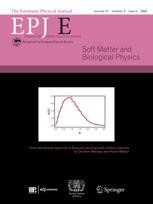Measuring nanocomposite structures with neutron and x-ray scattering
Experiments with state-of-the-art scattering instruments reveal an absence of specific patterns in the x-rays scattered by nanocomposite materials. With the help of advanced simulation techniques, a new study suggests that attractive interactions between nanoparticles with diverse shapes and sizes are most likely responsible for this behaviour.
New York | Heidelberg, 17 July 2023
 Small-angle scattering of x-rays and neutrons is a useful tool for studying molecular and nanoparticle structures. So far, however, experiments have revealed a surprising lack of nanoparticle structure in certain nanocomposite materials – whose molecular skeletons are reinforced with nanoparticles previously treated with polymer adsorption. In a new approach detailed in EPJ E, Anne-Caroline Genix and Julian Oberdisse at the University of Montpellier, France, show that these patterns can only be produced through attractive interactions between nanoparticles with a diverse array of shapes and sizes. The duo’s results highlight the rapidly improving capabilities of small-angle scattering instruments, and could also help researchers to improve their techniques for studying nanocomposites – with applications in areas including miniaturised electronics, biological tissue engineering, and strong, lightweight materials for aircraft.
Small-angle scattering of x-rays and neutrons is a useful tool for studying molecular and nanoparticle structures. So far, however, experiments have revealed a surprising lack of nanoparticle structure in certain nanocomposite materials – whose molecular skeletons are reinforced with nanoparticles previously treated with polymer adsorption. In a new approach detailed in EPJ E, Anne-Caroline Genix and Julian Oberdisse at the University of Montpellier, France, show that these patterns can only be produced through attractive interactions between nanoparticles with a diverse array of shapes and sizes. The duo’s results highlight the rapidly improving capabilities of small-angle scattering instruments, and could also help researchers to improve their techniques for studying nanocomposites – with applications in areas including miniaturised electronics, biological tissue engineering, and strong, lightweight materials for aircraft.
When beams of x-rays or neutrons interact with atoms in material samples, the resulting transfer of momentum causes them to scatter in characteristic patterns, which vary depending on the sample’s molecular structure. In recent years, instruments for measuring this scattering have rapidly improved, offering faster data acquisition, as well as more accurate and extensive measurements of the changes in particles speeds and directions.
In their recent research, Genix and Oberdisse have used the technique to study the structures of concentrated, polymer-based nanocomposites. It is well known that at high nanoparticle concentrations, interactions between the particles modify the scattering pattern. Yet surprisingly in their experiments, the duo found that this didn’t seem to happen: instead, the x-ray scattering patterns they observed seemed to indicate individual nanoparticles. To explain this result, the researchers performed numerical simulations to relate the positions of nanoparticles in space to the scattering patterns they observed.
They discovered that for high nanoparticle concentrations, attractive interactions between nanoparticles with a diverse array of shapes and sizes produces an almost ‘structureless’ state in the nanocomposite – explaining the lack of specific features in their observations. This discovery offers important insights into the molecular properties of nanocomposites and how they could be engineered to optimise their unique properties.
References: Genix, AC., Oberdisse, J. On the absence of structure factors in concentrated colloidal suspensions and nanocomposites. Eur. Phys. J. E 46, 46 (2023). https://doi.org/10.1140/epje/s10189-023-00306-6
Further Information
For more information visit: www.epj.org
Services for Journalists
The full-text article is available here.
Contact
Sabine Lehr | Springer | Physics Editorial Department
tel +49-6221-487-8336 | sabine.lehr@springer.com
